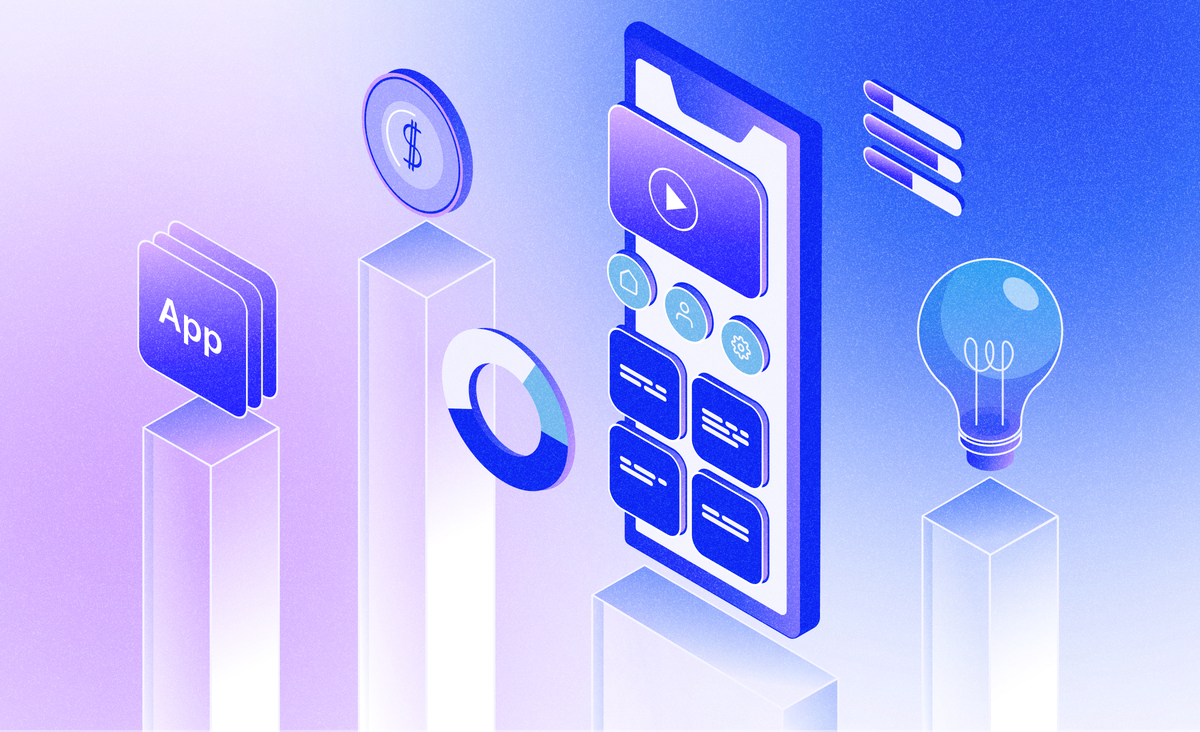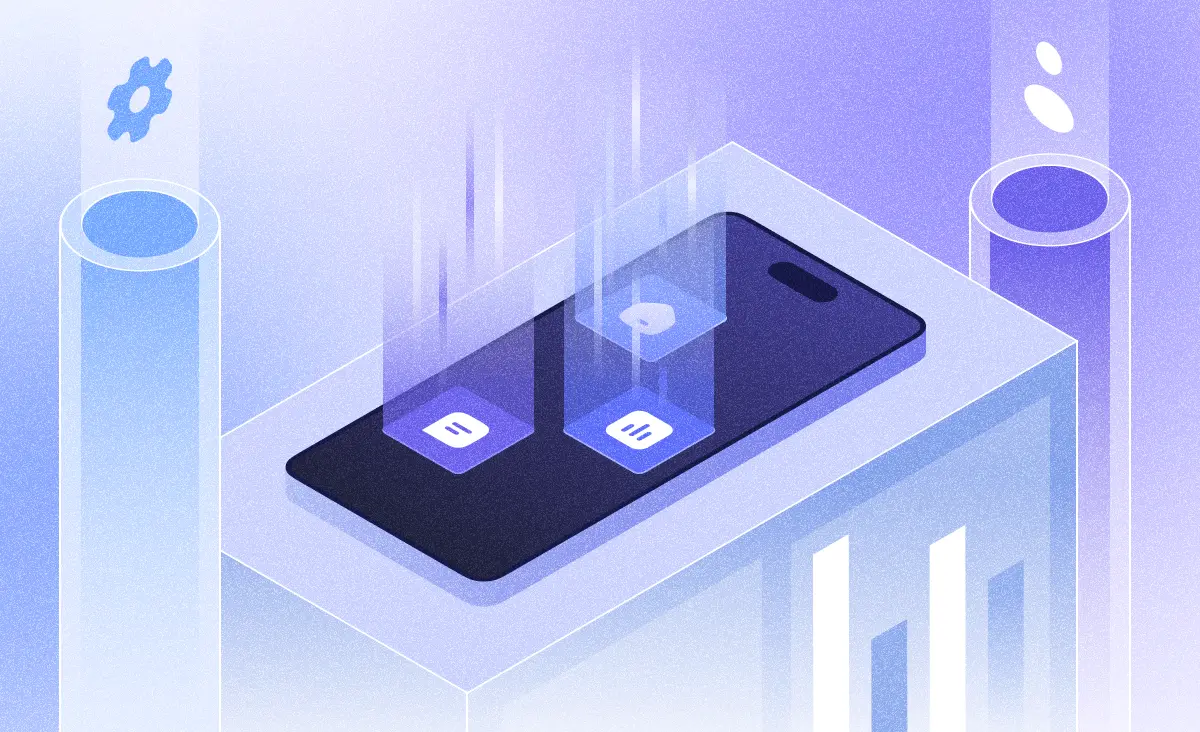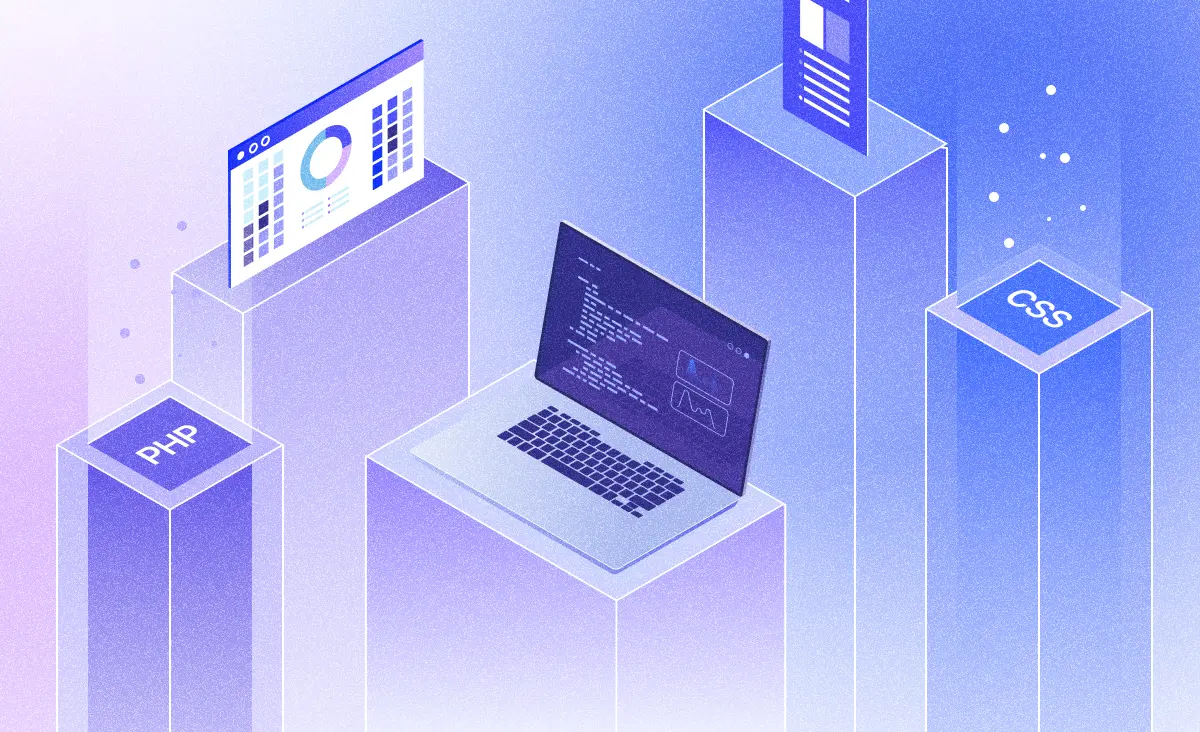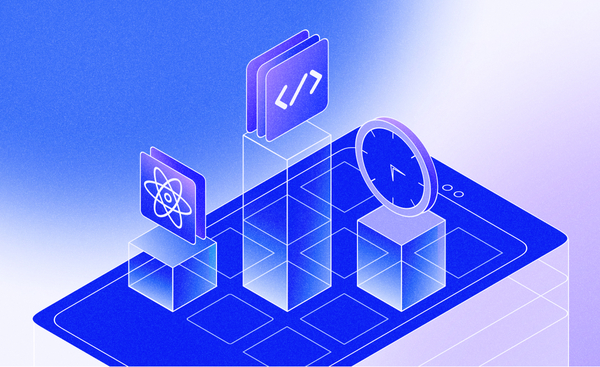Custom applications help businesses aiming to boost their digital footprint. The apps act as bespoke solutions, tailored to address the distinct demands of your business while ensuring a seamless customer experience. But one question lingers in the mind of every business owner: What is the custom app development cost? This article dissects that cost, offering invaluable insights for entrepreneurs.
Why Companies Need Custom App Development
The importance of custom app development cannot be understated. Custom apps cater specifically to your business needs, providing superior flexibility over off-the-shelf products. Embracing custom application development allows businesses to adapt swiftly with evolving market trends, always keeping them one step ahead.
Custom apps also ensure extensive integration with existing enterprise software, offering a harmonious business ecosystem. This not only leads to improved operational efficiency but also reduces the chances of data discrepancies. Automation of certain repetitive tasks via these applications eliminates human-generated errors and contributes to heightened productivity. Moreover, custom apps ensure improved scalability as compared to their generic counterparts, making them a future-proof investment for growing businesses.
According to Statista, during the initial quarter of 2023, around 27 billion apps were acquired by users from Google Play, while the Apple App Store saw roughly 8.1 billion app downloads.
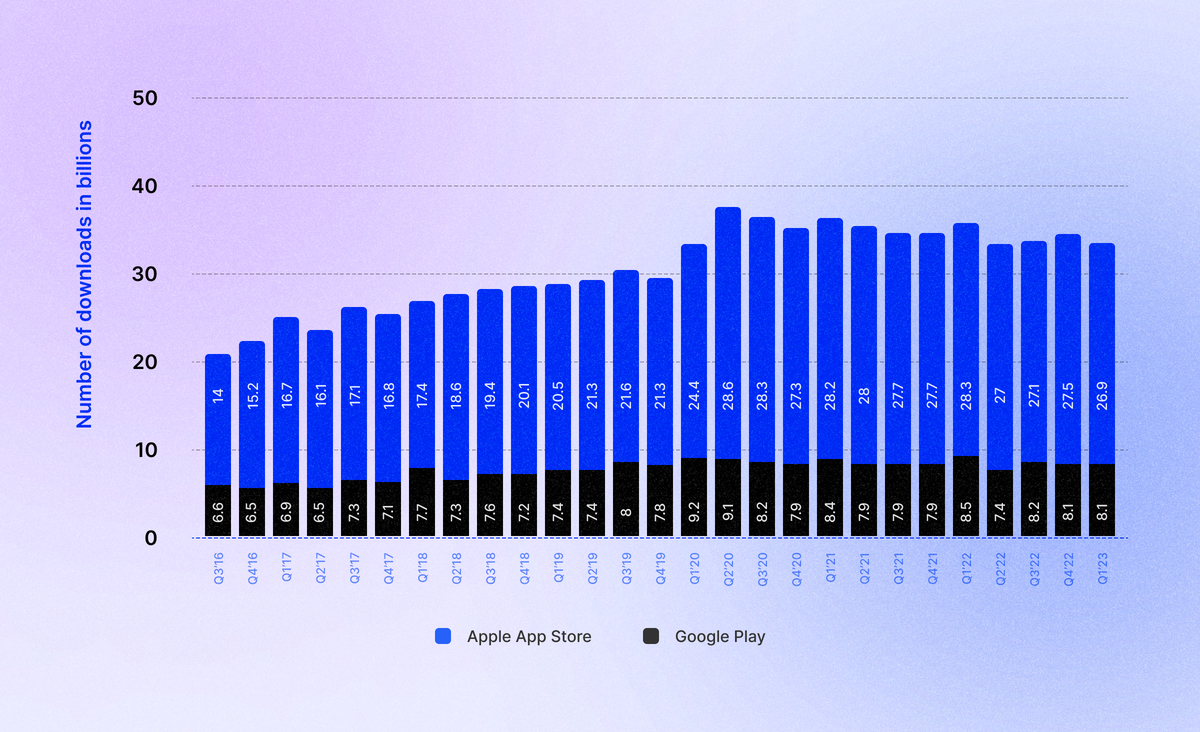
As you see, to compete with all these apps on the store, businesses need differentiation. Custom apps allow brands to stand out by delivering a unique and engaging user experience — giving them a competitive advantage over rivals.
Key Determinants of Custom App Development Cost
Custom app development cost is not a fixed figure. Assessing the cost of custom app development can sometimes feel like stepping into unknown terrain. Numerous factors come into play, each contributing to the final quotation you receive from your development team. Knowing these key determinants will aid in understanding how your budget is allotted and, ultimately, how to control development costs.
- App Platform: The choice between Android, iOS, or a cross-platform app directly affects the development cost. Typically, developing an iOS app might have a slightly higher cost than an Android app, largely because of its strict design requirements. Cross-platform apps, though, can save up to 30% in costs compared to native apps.
- Complexity and Functionality: The number and nature of features included in the app design significantly impact the overall cost. A simple app with basic functionality costs less than a complex one with advanced features like AI, VR, AR, ML, payment gateways, and third-party integrations.
- App Design: Custom aesthetics and intricate user interfaces (UI) demand a longer design cycle, directly increasing the cost. Highly intuitive and immersive User Experiences (UX) often require innovative design approaches that will up the cost.
- App Maintenance: Post-launch, your app will need regular updates, bug fixes, backend server maintenance, and performance improvements — all these ongoing services add to the total custom app development cost.
- Geographic Location: The geographical location of your app development team can impact the rates charged. Developers in North America often charge higher hourly rates compared to those based in Asia.
- Team Size: A smaller team might have a longer delivery timeline, but hiring a large team to speed up the process will also ramp up the development cost.
- Security Measures: If your app is dealing with sensitive data, implementing top-tier security features is a must. The cost involved in guaranteeing robust security can’t be overlooked.
- Customization Degree: While customization can help your app stand out, it also requires more resources, driving up the development cost.
Understanding these factors gives you better control over the development cost, enabling you to make informed decisions when planning and budgeting for your custom app.
Custom App Development Cost: An In-Depth Look
Estimating custom app cost is complex as it encompasses various stages. From the initial phase of conceptualizing the app idea and defining its key functionalities to designing the UI/UX, programming, quality testing, and deployment, every stage has its unique costs.
The design phase, for example, requires a planning-intensive approach. It could be pricier if the design needed is high-fidelity with intricate detailing. The complexity of programming also impacts cost — the more intricate the code, the higher the price. Additionally, rigorous QA testing is crucial to catch bugs and glitches that could otherwise impede user experience. Neglecting this stage could lead to significant post-deployment costs.
Cost Reduction Strategies for Custom App Development
As businesses turn to custom app development to meet their specific needs, one critical requirement takes precedence: cost efficiency. Understanding how to leverage cost reduction strategies for custom app development can pave the way for higher ROI. Here’s a brief rundown of some practical measures to optimize your development budget without cutting corners on quality.
- Deciding Between Hybrid and Native: Understanding your needs would guide whether to opt for a hybrid or native app. Hybrid apps have shorter development times and lower costs with universal compatibility. Native apps, while pricier, offer higher performance and a better user experience.
- Careful Planning: A well-designed project timeline paired with clearly-defined goals is a significant cost-saver. It helps developers understand your expectations and manage resources effectively, preventing oversights that may surge the budget.
- Lean Development: Starting with a Minimum Viable Product (MVP) can greatly reduce initial custom app development costs. An MVP allows you to introduce the basic features of your app to the market, gather feedback, and make improvements. Gradually, as the user base grows, you can expand functionality.
- Automation: Automated testing decreases the overall app development time, identifying and fixing bugs quicker than manual testing. Hence, overall production costs can be reduced significantly over time.
- Regular Maintenance: Consistent updates and regular maintenance can help the app avoid major issues that could otherwise lead to expensive overhauls.
- Choosing the Right Team: Opting for an experienced development team might seem like an added expense initially, but their expertise can eventually save costs because of efficient resource management and flawless execution.
- Open Source Tools: Using open-source tools for custom app development can also bring down the expenses as they are publicly accessible and free of cost while providing a high quality of coding efficiency.
Remember, the lowest cost option isn’t always the best choice. It’s crucial to strike a balance between affordability and quality. These strategies, if smartly executed, can value engineered and optimize your custom app development process. With smart planning and strategic insights, you can cap your development cost without skimping on quality. A well-defined set of app requirements and functionalities can help avoid unnecessary revisions, thus saving development time and cost.
Case Studies on Custom App Development Cost
Understanding the cost of custom app development from real-world scenarios can provide deep insights. Various businesses of different sizes and sectors have leveraged custom apps. Analyzing their approach to development, costs incurred, and subsequent return on investment paints a clearer picture of what to expect in such projects. This practical examination can inform a business’s developing strategy, ensuring the achievement of goals without unnecessary expenditure.
Developing a custom app can vary in cost, from as low as $5,000 to well above $500,000, depending not only on the app’s complexity, but on several other factors as well. Here are three real-life case studies showcasing the different scales and costs of custom app development:
1. Evernote — A Basic Productivity App
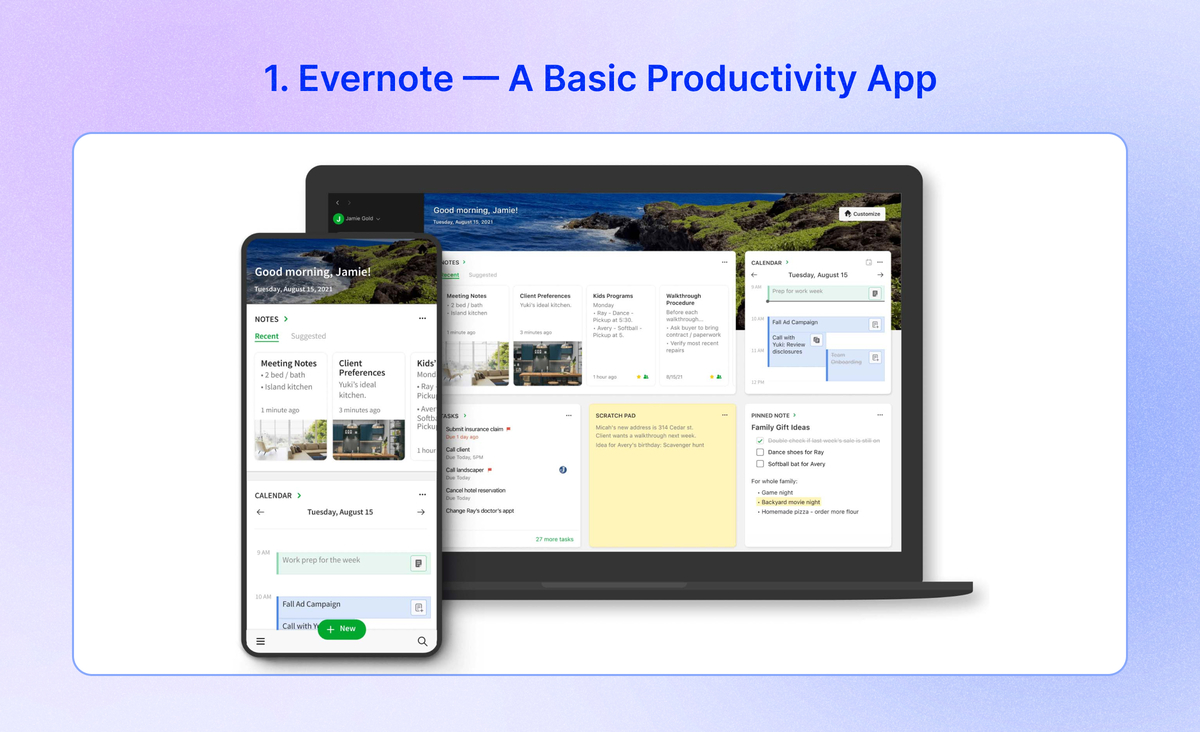
Evernote is a prime example of a basic productivity app. It was initially introduced as a minimum viable product, designed to allow users to make and store notes. The app has since expanded to include more capabilities like document scanning, task management, and collaboration tools. From our experience, the primary custom app development cost could be relatively low, estimated at approximately $50,000. As features were added, ongoing development costs significantly increased the total cost.
2. InkHunter — A Moderate Complexity App
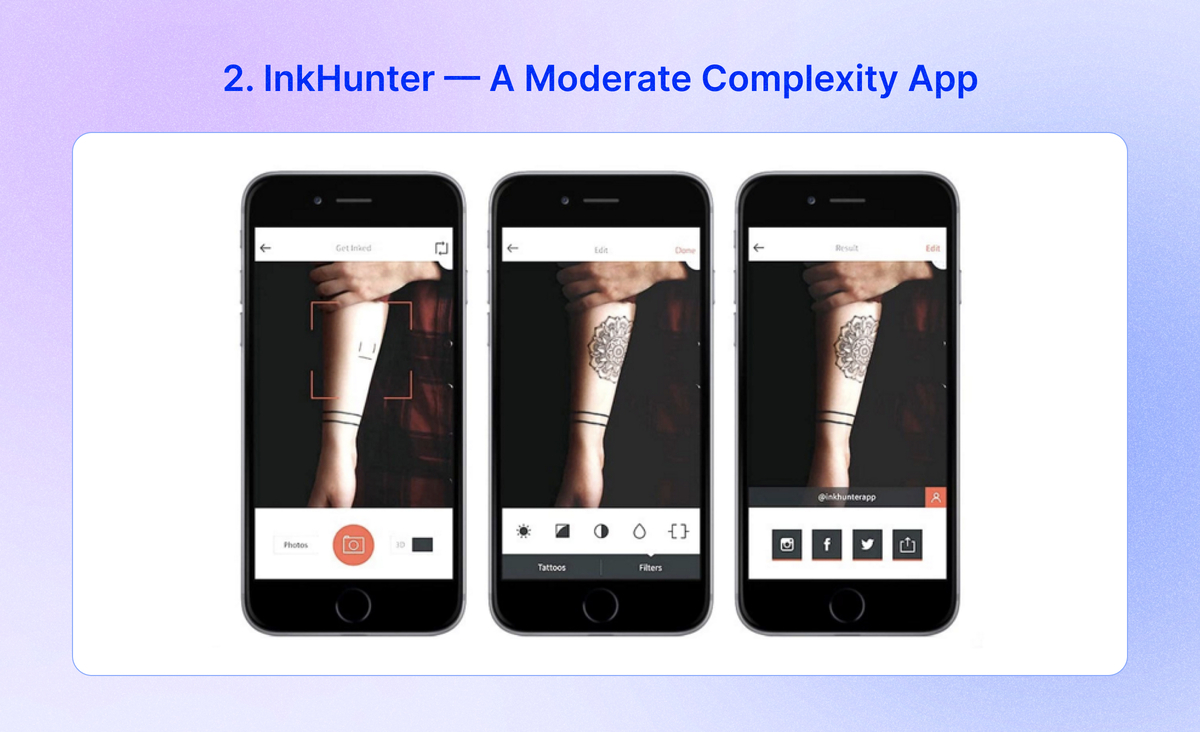
InkHunter, a mobile application that allows users to try on virtual tattoos using augmented reality (AR) technology, falls under the moderately complex category. Factoring in the inclusion of AR tech, sophisticated interface, and more complex features than a basic productivity app, we can suggest that the initial development cost for InkHunter was around $150,000. As with Evernote, continuous updates and added features increased overall app development costs over time.
3. Uber — A High Complexity App
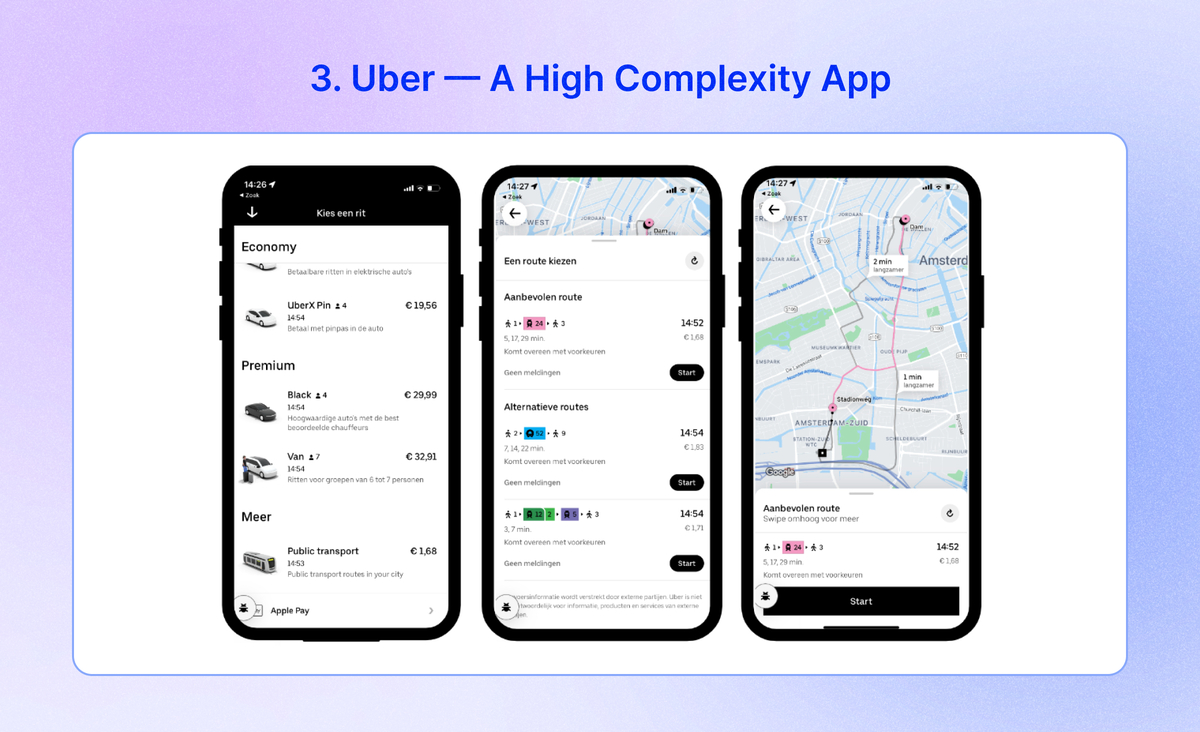
Uber, a ride-hailing app that operates globally, belongs in the high complexity category. The app functions on a Dual-interface — one for riders and another for drivers. Features such as geolocation, payment integration, constant server support, and an advanced algorithm for ride allocation all contribute to its complexity. Uber’s initial development cost can be estimated at about $1 Million. Ever evolving, the app undergoes regular updates and additions of new functionalities, leading to subsequent costs.
Each of these examples underscores that the initial development cost of any app is just a fraction of the cost. Continued innovation, addition of features, and routine maintenance are factors that add to the ongoing expenditure. Therefore, adopting a long-term perspective while budgeting for a custom app is essential.
Calculating Your Custom App Development Cost
Getting a precise estimate of your custom app development cost requires a thorough understanding of your project’s needs. Detailing these specifications (platform, design, functionalities) leads to a more accurate quote. This planning phase also enables potential developmental hurdles to be identified, allowing strategies to curtail these to be enacted beforehand. When you have a detailed quote, you can allocate your budget accurately and avoid unexpected expenses.
Conclusion
In conclusion, the custom app development cost for your business cannot be determined by a one-size-fits-all figure. Every app is unique in its design, features, functionality, and the inherent value it offers to your business. However, understanding the determinants that influence the cost of development — from the choice of platform and design complexity, to security measures and maintenance needs — can equip you with the knowledge to plan your budget effectively. By acknowledging these aspects, you can work on strategies to streamline costs without compromising on the app’s quality, functionality, or impact on your business.
As technology continues to drive the world’s businesses, custom applications are becoming a significant part of a successful operational strategy. They offer a myriad of advantages — from fulfilling unique business needs and providing extensive integration, to enabling scalability and differentiation in the market. Irrespective of the cost, investing in custom app development is not just a technology expenditure but rather, a strategic investment that can act as a strong catalyst in achieving your business objectives. By effectively managing the cost determinants and adapting cost reduction strategies, businesses can get the most out of custom app development, thereby paving the way for long-term success.
